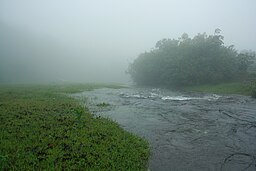Hiranyakeshi river
| Hiranyakeshi River | |
| River | |
|
Rapid currents of the Hiranyakeshi river near its 'ugam'
|
|
| Country | India |
|---|---|
| States | Maharashtra, Karnataka |
| Source | Chaukul |
| Mouth | Ghataprabha River |
The Hiranyakeshi river is a left-bank tributary of the Ghataprabha River originating in the western ghats in the Sindhudurg district of Maharashtra.
The river derives its name from the Shri Hiranyakeshi temple. Located inside the temple are caves from where the river originates as a fresh mountain stream. Hiranyakeshi is a sanskrit word which means "one with golden hair" with respect to the goddess Parvati in the temple. The temple itself is supposed to be situated in a "Devrai" or a sacred groove as is labelled by the locals.
The river begins in the Hiranyakeshwar temple, a holy shrine dedicated to the goddess Parvati near the hill-station of Amboli. It quickly flows in a north-west direction towards Jakatwadi, a small village next to Amboli. There the river turns right almost at a right angle and begins to flow eastwards similar to most rivers flowing on the Deccan Plateau. It flows underneath a bridge supporting state highway 121, which was named by the British as Victoria Jubilee Bridge. Then on, it takes a north-eastward course till it reaches the town of Ajra in the Kolhapur district of Maharashtra.
2 km before it reaches Ajra, the river plunges over a rocky ledge measuring about 5 metres in height forming the Ramteerth falls. A famous tourist spot, the Ramteerth temple of Lord Ram & Shiv, lies on the banks of the river near the falls. A legend says that Lord Ram had been staying here for some time during his Vanvas. The river then crosses underneath a bridge for the second time. It continues its run now along the right side of SH 134 crossing over into the Belgaum district, Karnataka. At the town of Sankeshwar it begins its short south-eastward course before it confluences with Ghataprabha river.
...
Wikipedia

